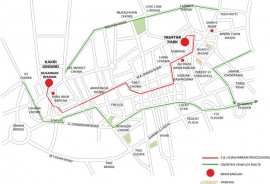
The Express Tribune dug into who is at fault when it comes to the traffic jams that surround U-turns at nearly all major thoroughfares. However, it seems the authorities are equally perplexed.
Traffic dig: Asif Aijaz Shaikh replaces Amir Shaikh
When contacted, then Traffic DIG Amir Shaikh believed the fault lies with the designing of U-turns. "The municipal corporations do not design U-turns to help citizens but to facilitate marriage halls, superstores and other business ventures," he told The Express Tribune before proceeding on several months' leave out of the country.

Sheikh pointed out a U-turn between Moti Mahal and Gulshan Chowrangi at Rashid Minhas road. He added that at one side of this U-turn lie crowded marriage halls with no parking and two mobile malls on the other side, also without a parking facility.
He explained that making a U-turn on Rashid Minhas road, considered one of the widest thoroughfares of the city, right where the road becomes narrow is clueless.
Traffic AIG Tahir Noorani agrees. There are multiple U-turns in the city that are flawed in their planning, he said, adding that most of them are narrow, which makes it difficult for heavy vehicles to easily make a turn. "U-turns are built without keeping in mind the flow of traffic," he added.
Noorani gave the example of the recently closed U-turn on Rashid Minhas Road, near Centrum shopping mall. "It was one of the most important U-turns on the road," he said. "After its closure, drivers have to travel approximately four kilometres all the way to Nipa flyover to make a U-turn. Why would anyone travel that long? People would just prefer to go the wrong way."
Roadblocks hit intercity traffic
The head of the traffic engineering department of Karachi Development Authority, Qazi Abdul Qadir, admitted that a few U-turns have been proved faulty. He claims that despite the increasing flyovers and underpasses the city will continue to face traffic problems until the mass transit plan for the city is initiated. Qadir claimed that they are waiting for the allocation of funds to relocate a few U-turns of the city.
Poor policing
The traffic engineers believe, however, that the problem lies with poor law enforcement. "It is more about the enforcement of traffic laws by the police than blaming the planning and design of the U-turns," said traffic engineer Ashar Lodhi. It seems that the traffic police as well as the commuters do not even consider it a violation of the law when driving the wrong way, he pointed out.
Lodhi gave the example of Dubai where U-turns are located at least 10 kilometres apart but there is still no trend of driving wrong way only because of strict enforcement of the law.
Sheikh admitted that fines no longer act as deterrents. "The low fine against the ticket makes no difference to drivers who continue to drive wrong way," he said. He blamed the short-staffed traffic police force and the lack of equipment as the main reasons behind poor law enforcement.
As the authorities shift blame, researchers warn that dangerous U-turns can be fatal. In 2015, around 2,070 injuries were reported while 19 people lost their lives on Sharae Faisal alone, said Prof Rashid Jumma, who is the principal investigator at the Road Traffic Injury Prevention Centre. "The negligence of commuters as well as the ineffectiveness of the traffic department is to blame for this," he said.
Published in The Express Tribune, October 29th, 2016.


























1714024018-0/ModiLara-(1)1714024018-0-270x192.webp)









COMMENTS
Comments are moderated and generally will be posted if they are on-topic and not abusive.
For more information, please see our Comments FAQ